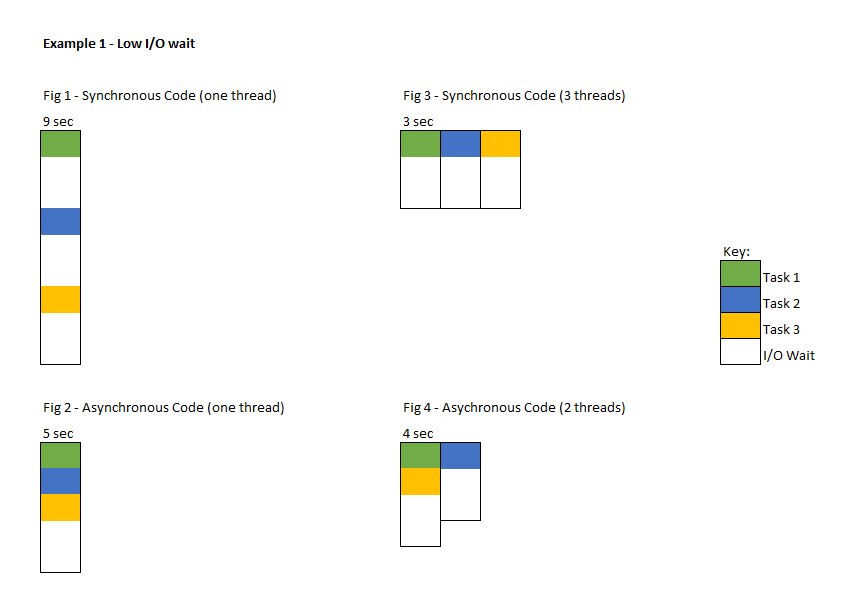恐怕我仍然有点困惑(尽管检查了其他线程)是否:
我最初的猜测是否定的,正确的异步代码应该能够在一个线程中运行 - 但是可以通过添加线程来改进它,例如:

所以我构建了这个玩具示例:
from threading import *
from queue import Queue
import time
def do_something_with_io_lag(in_work):
out = in_work
# Imagine we do some work that involves sending
# something over the internet and processing the output
# once it arrives
time.sleep(0.5) # simulate IO lag
print("Hello, bee number: ",
str(current_thread().name).replace("Thread-",""))
class WorkerBee(Thread):
def __init__(self, q):
Thread.__init__(self)
self.q = q
def run(self):
while True:
# Get some work from the queue
work_todo = self.q.get()
# This function will simiulate I/O lag
do_something_with_io_lag(work_todo)
# Remove task from the queue
self.q.task_done()
if __name__ == '__main__':
def time_me(nmbr):
number_of_worker_bees = nmbr
worktodo = ['some input for work'] * 50
# Create a queue
q = Queue()
# Fill with work
[q.put(onework) for onework in worktodo]
# Launch processes
for _ in range(number_of_worker_bees):
t = WorkerBee(q)
t.start()
# Block until queue is empty
q.join()
# Run this code in serial mode (just one worker)
%time time_me(nmbr=1)
# Wall time: 25 s
# Basically 50 requests * 0.5 seconds IO lag
# For me everything gets processed by bee number: 59
# Run this code using multi-tasking (launch 50 workers)
%time time_me(nmbr=50)
# Wall time: 507 ms
# Basically the 0.5 second IO lag + 0.07 seconds it took to launch them
# Now everything gets processed by different bees
它是异步的吗?
对我来说,这段代码似乎不是异步的,因为它是我的示例图中的图 3。 I/O 调用阻塞了线程(虽然我们感觉不到,因为它们是并行阻塞的)。
但是,如果是这种情况,我很困惑为什么 requests-futures 被认为是异步的,因为它是 ThreadPoolExecutor 的包装器:
with concurrent.futures.ThreadPoolExecutor(max_workers=20) as executor:
future_to_url = {executor.submit(load_url, url, 10): url for url in get_urls()}
for future in concurrent.futures.as_completed(future_to_url):
url = future_to_url[future]
try:
data = future.result()
这个功能只能在一个线程上运行吗?
特别是与 asyncio 相比时,这意味着它可以运行单线程
There are only two ways to have a program on a single processor do “more than one thing at a time.” Multi-threaded programming is the simplest and most popular way to do it, but there is another very different technique, that lets you have nearly all the advantages of multi-threading, without actually using multiple threads. It’s really only practical if your program is largely I/O bound. If your program is processor bound, then pre-emptive scheduled threads are probably what you really need. Network servers are rarely processor bound, however.
最佳答案
首先,一个说明: concurrent.futures.Future 与 asyncio.Future 不一样.基本上它只是一个抽象 - 一个对象,它允许您在分配作业之后但在完成之前引用程序中的作业结果(或异常,也是结果)。这类似于将普通函数的结果分配给某个变量。
多线程 :关于您的示例,当使用多个线程时,您可以说您的代码是“异步”的,因为多个操作同时在不同线程中执行,而无需等待彼此完成,您可以在计时结果中看到它。你是对的,你的功能归功于 sleep正在阻塞,它会在指定的时间内阻塞工作线程,但是当您使用多个线程时,这些线程会被并行阻塞。所以,如果你想找一份工作 sleep另一个没有并运行多个线程,一个没有 sleep将执行计算,而另一个将 sleep 。当您使用单线程时,作业以串行方式一个接一个地执行,因此当一个作业休眠时,其他作业等待它,实际上直到轮到它们时它们才存在。您的时间测试几乎证明了所有这些。事情发生在 print与“线程安全”有关,即打印使用标准输出,这是一个单一的共享资源。因此,当您的多个线程尝试同时打印时,切换发生在内部,并且您得到了奇怪的输出。 (这也显示了多线程示例的“异步性”。)为了防止此类错误,有锁定机制,例如锁、信号量等。
异步 :为了更好地理解目的,请注意“IO”部分,它不是“异步计算”,而是“异步输入/输出”。在谈论 asyncio 时,您通常一开始不会考虑线程。 Asyncio 是关于事件循环和生成器(协程)的。事件循环是仲裁器,它管理注册到循环的协程(及其回调)的执行。协程被实现为生成器,即允许迭代执行某些操作的函数,在每次迭代和“返回”时保存状态,并在下一次调用时继续保存的状态。所以基本上事件循环是 while True:循环,它一个接一个地调用分配给它的所有协程/生成器,并且它们在每个这样的调用中提供结果或无结果 - 这为“异步”提供了可能性。 (一种简化,因为有调度机制,可以优化这种行为。)这种情况下的事件循环可以在单线程中运行,如果协程是非阻塞的,它会给你真正的“异步性”,但如果它们是阻塞的,那么它基本上是线性执行。
您可以使用显式多线程实现相同的目的,但线程成本高昂 - 它们需要分配内存,切换它们需要时间等。另一方面,asyncio API 允许您从实际实现中抽象出来,只考虑要执行的作业异步。它的实现可能不同,它包括调用 OS API 和 OS 决定做什么,例如DMA、附加线程、一些特定的微 Controller 使用等。问题是由于较低级别的机制、硬件内容,它对 IO 运行良好。另一方面,执行计算需要将计算算法显式分解为多个部分以用作 asyncio 协程,因此单独的线程可能是更好的决定,因为您可以在那里启动整个计算。 (我不是在谈论并行计算所特有的算法)。但是 asyncio 事件循环可能被明确设置为对协程使用单独的线程,因此这将是具有多线程的 asyncio。
关于您的示例,如果您将使用 sleep 实现您的功能作为 asyncio 协程,调度并运行其中 50 个单线程,您将获得与第一次测试相似的时间,即大约 25s ,因为它正在阻塞。如果您将其更改为类似 yield from [asyncio.sleep][3](0.5) 的内容(这是一个协程本身),将其中的 50 个单线程运行,它将被异步调用。因此,当一个协程将休眠时,另一个协程将启动,依此类推。作业将在类似于您的第二个多线程测试的时间内完成,即接近 0.5s .如果您要添加 print在这里,您将获得良好的输出,因为它将以串行方式由单线程使用,但输出的顺序可能与协程分配给循环的顺序不同,因为协程可以以不同的顺序运行。如果您将使用多个线程,那么结果显然会接近最后一个。
简化:multithreading 和 asyncio 的区别在于阻塞/非阻塞,所以基本上阻塞多线程会有点接近非阻塞 asyncio,但有很多不同。
关于你的原始陈述:
- all asynchronous code is multi-threaded
- all multi-threaded functions are asynchronous
我希望我能够证明:
- asynchronous code might be both single threaded and multi-threaded
- all multi-threaded functions could be called "asynchronous"
关于python - 这个多线程函数是异步的吗,我们在Stack Overflow上找到一个类似的问题: https://stackoverflow.com/questions/35835219/